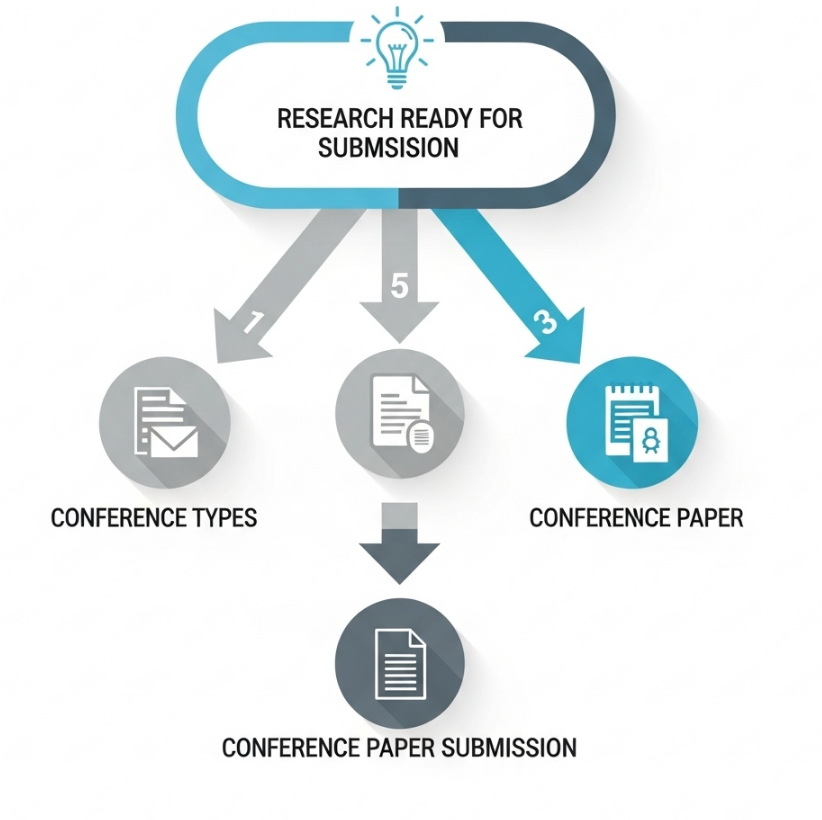You've completed your research, analyzed
the data, and are ready to share your findings with the world. You find a
promising academic conference and navigate to the "Call for Papers"
page, only to be faced with a critical question: do you need to write a
complete, full-length paper right now?

The short answer is: it depends entirely
on the conference and its specific requirements.
Submitting to a conference isn't a
one-size-fits-all process. Different fields and different events have varying
requirements for the initial submission. This guide will clarify the common
submission formats, explain the process, and help you understand exactly what
you need to prepare.
Understanding the Two Main Stages:
Review vs. Publication
First, it's helpful to think of the
conference submission process in two potential stages:
- The Initial Submission (for Review): This is the document you first submit for the committee to
evaluate. Its purpose is to get your work accepted for presentation
(either oral or poster).
- The Final Submission (for Publication): If your work is accepted, you will often be asked to submit a
final, perfectly formatted version for the official conference proceedings.
The requirement for a full paper differs
significantly between these two stages.
Common Formats for the Initial Review
Stage
Here are the three most common formats
you'll encounter when first submitting your work.
1. Full Paper Submission
- What it is: A complete academic
paper, typically 6-12 pages long, including an abstract, introduction,
methodology, results, conclusion, and references. It should be a polished,
publication-ready manuscript.
- Who requires it: This is standard
practice for highly competitive conferences, especially in fields like computer
science, engineering, and robotics (e.g., top-tier IEEE or ACM
conferences).
- Why: It allows for a rigorous and
thorough peer-review process, where experts can scrutinize your entire
research from start to finish. The paper that is accepted is often very
close to the final version that will be published.
- Bottom Line: Yes, in this case, you
must write the full paper from the very beginning.
2. Extended Abstract Submission
- What it is: A more detailed summary
of your work, typically 1-3 pages long. It goes beyond a simple abstract
and usually includes a brief introduction, an overview of the methodology,
key figures or results, and a short conclusion.
- Who requires it: This is a very
common format in many science and engineering disciplines.
- Why: It provides reviewers with
enough information to judge the quality, novelty, and suitability of your
research without requiring the author to prepare a complete manuscript
upfront. It's a balance between detail and efficiency.
- Bottom Line: You don't need a full
paper yet. If your extended abstract is accepted, you will almost
certainly be required to write and submit a full paper for the
proceedings.
3. Abstract-Only Submission
- What it is: A short, concise
summary of your research, usually between 200-500 words. It briefly
outlines the study's background, purpose, methods, main findings, and
conclusions.
- Who requires it: This is very
common in the humanities, social sciences, medicine, and for many life
sciences conferences. It is also the standard format for poster
presentation submissions.
- Why: It allows the organizing
committee to quickly assess if your research fits the conference theme and
is of interest to the audience. The focus is on building a diverse and
relevant program of presentations.
- Bottom Line: You only need to write
an abstract to get accepted. Often, the conference may not even publish
formal proceedings, so a full paper might never be required. In
other cases, submitting a full paper for the proceedings is optional.
After Acceptance: The
"Camera-Ready" Full Paper
If your submission (full paper, extended
abstract, or abstract) is accepted, you will receive instructions for the final
version. This is often called the "camera-ready" paper.
The term originates from the days of print,
meaning the document was ready to be photographed and printed. Today, it means
your paper must be perfectly formatted according to the publisher's template
(e.g., IEEE, Springer, ACM) and submitted digitally for inclusion in the
official conference proceedings, which are often published on platforms like
IEEE Xplore or the ACM Digital Library.
The Golden Rule: Always Check the
"Call for Papers"
So, how do you know what to write? The
answer is always on the conference website.
Look for sections titled "Call for
Papers," "Author Guidelines," "Submission
Instructions," or "For Authors." These pages will tell you
everything you need to know, including:
- The required format for the initial submission.
- The strict page limits.
- The formatting template to use.
- What is required after acceptance.
In conclusion, the need to write a full
paper depends entirely on the conference's policy and the stage of the process.
For highly competitive, publication-focused events, the answer is yes, from the
start. For many others, you may only need an abstract or an extended abstract
to get your foot in the door.


